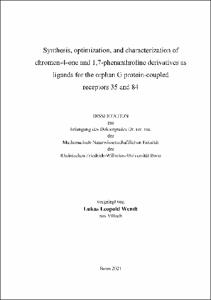Synthesis, optimization, and characterization of chromen-4-one and 1,7-phenanthroline derivatives as ligands for the orphan G protein-coupled receptors 35 and 84

Synthesis, optimization, and characterization of chromen-4-one and 1,7-phenanthroline derivatives as ligands for the orphan G protein-coupled receptors 35 and 84

| dc.contributor.advisor | Müller, Christa | |
| dc.contributor.author | Wendt, Lukas Leopold | |
| dc.date.accessioned | 2021-06-21T00:23:38Z | |
| dc.date.available | 2023-08-01T22:00:15Z | |
| dc.date.issued | 21.06.2021 | |
| dc.identifier.uri | https://hdl.handle.net/20.500.11811/9172 | |
| dc.description.abstract | G protein-coupled receptors (GPCRs) are ideal drug targets. Their characteristic tissue distribution, marked ligand specificity, and their roles in countless (patho)physiological processes are being exploited by more than a third of currently available pharmaceutical drugs. However, a substantial number of GPCRs is still underexplored. The so-called orphan receptors are promising new drug targets with unique properties and the potential to expand available treatment options. Unfortunately, the inadequate knowledge of their endogenous activators has hampered target validation studies and drug development as a consequence.
GPR35 and GPR84 are orphan receptors, and both have essential functions in health and disease. While GPR35 promotes anti-inflammatory activities and plays a role in cardiovascular diseases, energy metabolism, and immune regulation, and is predominantly expressed in the gastrointestinal tract,1 GPR84 was described as a pro-inflammatory receptor. It is mainly expressed on immune cells and upregulated during infection or stress. Efforts to identify the cognate ligands of these receptors have prompted disagreement in the scientific community, since no proposed ligand could convince regarding potency and selectivity. Thus, synthetic ligands are necessary tools to study orphan receptors such as GPR35 and GPR84. Whereas only few surrogate ligands with high potency have been described for GPR84, many structurally diverse agonists are available for GPR35 – including well-known pharmaceutical drugs and excipients, such as cromolyn, furosemide, and pamoic acid.4 However, these ligands are notoriously inactive at the rat and especially mouse GPR35 orthologs, which prevents their use in animal studies and impedes preclinical drug development. Even the most potent chromen-4-one-based GPR35 agonists developed by our group were highly human-selective, and recent efforts to obtain derivatives with substantially increased rodent GPR35 activity were unsuccessful. In our research, we aimed to enhance our scaffold’s activity at the rat and mouse receptor orthologs. Compounds 1 (LW372) and 2 (LW345) displayed markedly increased potency at the rat and mouse GPR35 compared to the previously reported 3 (PSB-21028), yet their activity at the human ortholog was still significantly stronger. Based on a report by MacKenzie et al., we also optimized the structure of bufrolin, a failed clinical candidate for the treatment of allergic asthma. It had shown high and equipotent activity at the human and rat GPR35, and by chemically introducing structural modifications, we successfully increased mouse receptor potency. The resulting compounds 4 (LW241) and 5 (LW463) are the first GPR35 agonists with single-digit nanomolar potency at the mouse receptor ortholog. Considering their equally high affinity and potency at the human and rat receptors, they represent the most useful GPR35 agonists for animal studies currently in existence. The compounds were selective for GPR35 versus a variety of similar GPCRs, including the most closely related GPR55 (sequence similarity: 53%). Preliminary drug metabolism and pharmacokinetic studies demonstrated considerable metabolic stability in vitro, relatively high aqueous solubility, yet low membrane permeability. As such, the compounds are ideal for local application, e.g., in the lungs or the gastrointestinal tract, where GPR35 expression is high, minimizing systemic side effects. Our GPR84 antagonists were based on the previously reported 6 (PSB-17138), which already exhibited nanomolar affinity for the receptor. Its physicochemical properties, on the other hand, were inadequate. The molecule’s extremely high lipophilicity (log D7.4 2.83) negatively affected its solubility and impeded clinical development. By introducing polar structural elements and carefully monitoring their effects on affinity and potency, we successfully increased the lead compound’s polarity and significantly enhanced biological activity. Compound 7 (LW500) is dramatically less lipophilic than the lead (log D7.4 1.00) and exhibited ~10-fold higher affinity for GPR84. It is also the most potent GPR84 antagonist currently in existence, which occupies the receptor’s fatty acid binding site. | en |
| dc.language.iso | eng | |
| dc.rights | In Copyright | |
| dc.rights.uri | http://rightsstatements.org/vocab/InC/1.0/ | |
| dc.subject | GPR35 | |
| dc.subject | GPR84 | |
| dc.subject | G-protein-gekoppelt | |
| dc.subject | natürlicher Ligand | |
| dc.subject | Phenanthrolin | |
| dc.subject | Chromenon | |
| dc.subject | Chromon | |
| dc.subject | Chinolin | |
| dc.subject | G protein-coupled | |
| dc.subject | natural ligand | |
| dc.subject | phenanthroline | |
| dc.subject | chromenone | |
| dc.subject | chromone | |
| dc.subject | quinoline | |
| dc.subject | quinolone | |
| dc.subject | kynurenic acid | |
| dc.subject.ddc | 500 Naturwissenschaften | |
| dc.subject.ddc | 540 Chemie | |
| dc.subject.ddc | 610 Medizin, Gesundheit | |
| dc.subject.ddc | 615 Pharmakologie, Therapeutik | |
| dc.title | Synthesis, optimization, and characterization of chromen-4-one and 1,7-phenanthroline derivatives as ligands for the orphan G protein-coupled receptors 35 and 84 | |
| dc.type | Dissertation oder Habilitation | |
| dc.publisher.name | Universitäts- und Landesbibliothek Bonn | |
| dc.publisher.location | Bonn | |
| dc.rights.accessRights | openAccess | |
| dc.identifier.urn | https://nbn-resolving.org/urn:nbn:de:hbz:5-62718 | |
| ulbbn.pubtype | Erstveröffentlichung | |
| ulbbnediss.affiliation.name | Rheinische Friedrich-Wilhelms-Universität Bonn | |
| ulbbnediss.affiliation.location | Bonn | |
| ulbbnediss.thesis.level | Dissertation | |
| ulbbnediss.dissID | 6271 | |
| ulbbnediss.date.accepted | 14.06.2021 | |
| ulbbnediss.institute | Mathematisch-Naturwissenschaftliche Fakultät : Fachgruppe Pharmazie / Pharmazeutisches Institut | |
| ulbbnediss.fakultaet | Mathematisch-Naturwissenschaftliche Fakultät | |
| dc.contributor.coReferee | Hansen, Finn | |
| ulbbnediss.contributor.orcid | https://orcid.org/0000-0002-1223-5646 | |
| ulbbnediss.date.embargoEndDate | 01.07.2022 | |
| ulbbnediss.date.embargoEndDate | 01.08.2023 | |
| ulbbnediss.contributor.gnd | 1262426251 |
Dateien zu dieser Ressource
Das Dokument erscheint in:
-
E-Dissertationen (4465)




